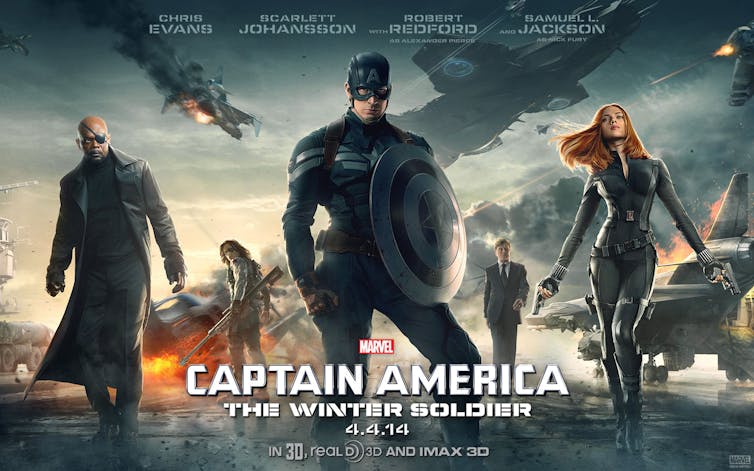Thor: Love and Thunder, the latest movie in the Marvel Cinematic Universe, has just hit Australian cinemas. Following Thor’s adventure in the aftermath of Avengers: Endgame, the film re-introduces Jane Foster, played by Natalie Portman, now as the Mighty Thor.
The Mighty Thor’s introduction adds to Marvel Universe’s growing roster of female superheroes, which includes characters such as Black Widow, Scarlet Witch, Captain Marvel, and Ms. Marvel.
But, more than just another name on the list, the Mighty Thor represents another type of female superhero: one who is physically strong and with the biceps to show for it.
Becoming the Mighty Thor
Jane Foster first appeared in Marvel Comics’ Journey into Mystery #84 as a nurse employed by Dr. Donald Blake, Thor’s alter-ego. In her early appearances, she serves as Thor’s love interest, often the damsel-in-distress in Thor’s daring exploits.
The Marvel Universe introduces Jane Foster in Thor as an accomplished astrophysicist. But, much like her counterpart in the comics, Foster’s arc revolves around being Thor’s love interest.

In the comics, Foster takes up Thor’s mantle after picking up the enchanted hammer Mjolnir following the original Thor losing his “worthiness”. And although Stan Lee and John Buschema emphasise that female superheroes in Marvel comics should be drawn “to look smooth and soft as opposed to the muscular, angular rendition of a man”, Foster’s Thor is anything but. As the Mighty Thor, Foster’s weak body, ridden with terminal cancer, transforms into a strong, statuesque body befitting a goddess warrior.
Thor: Love and Thunder loosely draws from Foster’s character arc in the comics. Natalie Portman’s Foster first appears in the film as she is undergoing treatment for her stage-four cancer. Having learned that Mjolnir gives its wielder great health, she travels to New Asgard seeking the hammer. Sensing Foster’s presence, the shattered pieces of Mjolnir restore itself and chooses Foster as its new wielder, transforming her into the Mighty Thor.
Portman, whose past roles often capitalise on her petite figure, spent 10 months training to “get as big as possible”. Fans got a first glimpse of Portman’s portrayal of the goddess of thunder in the film’s teaser trailer.
Like her comics counterpart, Marvel’s cinematic Mighty Thor sports a prominently muscular physique. When set photos of Portman in full Thor gears surfaced, the internet lost its collective mind over her jacked arms.

A different embodiment of the female superhero
The hyper-sexualisation of female superheroes in film is nothing new. Characters such as Catwoman, Black Widow and Wonder Woman have all suffered this fate. They are sexualised through their dialogues and mannerisms, not to mention the exposing costumes highlighting their bums and breasts, often with exposed cleavages. In the poster for Captain America: The Winter Soldier, for example, Black Widow is posed and positioned in a way that align the viewers with a sexualising gaze.

Films such as Black Panther and Captain Marvel have taken a better approach in representing their female characters. The women in these films are neither visually objectified nor defined by their roles as love interests. Instead, they unapologetically display their agency, skills and powers. Thor: Love and Thunder takes another step forward in the representation of embodiment of female heroism and power.
The Mighty Thor’s depiction in Thor: Love and Thunder is not without its problems, including her function in the narrative as a love interest and a tool for Thor’s character development. But, the character opens the possibility for a more diverse and inclusive representation of women’s bodies in mainstream superhero movies.
In addition to the more practical superhero suit, the Mighty Thor does not shy away from showing her muscles. This is why the character is a refreshing departure from the hyper-sexualisation of female superheroes before her.
Representations of female superpowers are often limited by gendered stereotypes. This is exemplified by the “hands off” power sets most female superheroes have, such as Scarlet Witch’s magic, Jean Grey’s telekinesis, and Emma Frost’s telepathy. The Mighty Thor is one of the rare examples where a female superhero is characterised by explicitly physical powers.
In a recent interview, Portman noted that her physical transformation to embody the character gave her an empowering “state of mind as a woman”. For female audiences as well, the Mighty Thor’s physical stature is a powerful visual representation.
Additionally, representations of women’s bodies in popular culture reflect gender conventions that associate femininity with slender and soft bodies. With the rare appearances of muscular women on the big screen, the Mighty Thor introduces a different physical representation that challenges traditional gender expectations of what femininity looks like.
As cultural products, superheroes not only reflect our culture but also inform our understanding of it, including the discourse around gender. So, representation of diversity – in terms of race, sex, gender, economics, sexual orientation, and shape – is important. We need more representation of different ethnic and cultural backgrounds. We also need more representation women of all shapes – tall, short, small, or large. For this reason, the Mighty Thor is a valuable addition to the new wave of strong female superheroes in the Marvel Cinematic Universe.
Ashika Paramita, PhD Candidate, Deakin University
This article is republished from The Conversation under a Creative Commons license. Read the original article.













